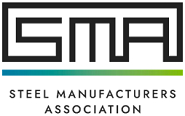Economy

SMA: The American Steel Industry is a Green Model for the World
August 13, 2021
By Philip Bell, President, Steel Manufacturers Association
Editor’s note: Phil Bell and SMA are now periodic contributors to Steel Market Update. Look for Phil’s insights on steel and events in Washington in future issues of SMU.
Many people often mischaracterize the American steel industry as dirty and struggling to cut carbon emissions. This all-too-common misperception needs to be cleared up. As readers of Steel Market Update, it is incumbent for us to fight this false narrative. When it comes to making steel, there is an old, carbon intensive, traditional way and a new, green and future-proof way.
![]() The old, traditional way of making steel is the blast furnace method, a manufacturing process that is used predominately in China, the EU and the rest of the world. This method generates large amounts of air and water pollution and consumes hefty quantities of energy. When you see articles in some media outlets, which try to insinuate that steel made in our country is just as dirty as foreign-made steel, you should take pause.
The old, traditional way of making steel is the blast furnace method, a manufacturing process that is used predominately in China, the EU and the rest of the world. This method generates large amounts of air and water pollution and consumes hefty quantities of energy. When you see articles in some media outlets, which try to insinuate that steel made in our country is just as dirty as foreign-made steel, you should take pause.
In our country steel is produced at carbon emission levels that others can only aspire to meet. Assumptions about our industry often ignore regional differences and current levels of environmental stewardship and attainment. This is particularly the case in America.
American steel is the greenest steel in the world. Americans concerned about the environment can feel good about the way we make steel. Simply put: American steel is sustainable steel.
America produces 70% of its steel using the electric arc furnace (EAF) process, while the rest of the world largely makes steel using the blast furnace manufacturing process. EAF steelmaking has up to 75% lower CO2 intensity than traditional steelmaking. The dominance of EAF production, a lesser reliance on seaborne raw materials, the use of pelletized iron ore, and an increasingly greener electricity grid are some of the factors that contribute to our success. The CO2 intensity of steel produced on our shores is the lowest of any major steel producing nation and less than half that of China or India.
China is leading the old, dirty way of making steel, and some would argue darkening the future of the global environment. For example, China produces more than half of the world’s steel, and the vast majority (90%) is made using blast furnaces. And China’s blast furnace manufacturing plants are relatively new with an average age of 12 years, which means massive amounts of air and water pollution will continue for many years to come. In fact, nearly 20 new blast furnace projects were announced in China in the last 12 months.
Compare this to sustainable American steel, which is manufactured at carbon intensity levels below that of the Paris Climate Accord targets, which are goals that some countries will not achieve for decades. Additionally, American steel companies are investing over $9 billion of capital for new or upgraded steel facilities between now and 2023. Most of these investments involve green, EAF steelmaking technology.
American steelmaking facilities are clean, modern and employ tens of thousands of people with high-tech, high-wage jobs. Many countries are trying to make their domestic steel industries look like ours. We should be proud of what we have accomplished and the innovations we will continue to make. The American steelmaking model is already green, and it works.
Phil Bell is president of the Steel Manufacturers Association (SMA). SMA is the largest steel industry trade association in the United States and is the primary trade association representing American EAF steel producers. Accounting for over 70% of domestic steelmaking production, EAF producers are the most sustainable steelmakers in the world. By using an innovative, 21st century production process that is less energy-intensive, domestic steelmakers have up to 75% lower carbon emissions than traditional steelmakers. SMA’s 24 producer members have operations in 35 states. For more information check out our website at www.steelnet.org or our Facebook page.
Latest in Economy

Steel groups welcome passage of budget bill
Steel trade groups praised the passage of the Big Beautiful Bill (BBB) in Congress on Thursday.

Industry groups praise Senate for passing tax and budget bill
The Steel Manufacturers Association and the American Iron and Steel Institute applauded the tax provisions included in the Senate's tax and budget reconciliation bill.

Chicago PMI dips 0.1 points in June
The Chicago Purchasing Managers Index (PMI) slipped 0.1 points to 40.4 points, in June.

Multi-family pullback drives housing starts to 5-year low in May
US housing starts tumbled in May to a five-year low, according to figures recently released by the US Census Bureau.

Architecture firms still struggling, ABI data shows
Architecture firms reported a modest improvement in billings through May, yet business conditions remained soft, according to the latest Architecture Billings Index (ABI) release from the American Institute of Architects (AIA) and Deltek.
